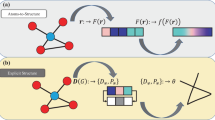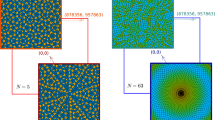Abstract
POLYHEDRAL cages and clusters are widespread in chemistry. Examples of fully triangulated polyhedra (deltahedra) are the skeletons of closo-boranes BnH2−n, many heteroboranes and transition-metal carbonyls1. Three-connected cages occur for carbon2,3 and in zeolites1. The numbers v, f and e of vertices, faces and edges of a convex polyhedron are related by Euler's theorem4,5 v+f=e + 2. Here we show that within the point group of the polyhedron the symmetries spanned by the sets of vertices, faces and edges are also related. We prove a general theorem relating these symmetries for convex polyhedra, and give further relations specific to deltahedra and 3-connected polyhedra. The latter extensions of Euler's theorem to point-group characters allow us to generate complete sets of internal vibrational coordinates from bond stretches for deltahedra, and to classify, from symmetry properties alone, the bonding or antibonding nature of molecular orbitals of 3-connected cages.
This is a preview of subscription content, access via your institution
Access options
Subscribe to this journal
Receive 51 print issues and online access
$199.00 per year
only $3.90 per issue
Buy this article
- Purchase on Springer Link
- Instant access to full article PDF
Prices may be subject to local taxes which are calculated during checkout
Similar content being viewed by others
References
Porterfield, W. W. Inorganic Chemistry: A Unified Approach (Addison-Wesley, Reading, Massachusetts, 1984).
Kroto, H. W. Nature 329, 529–531 (1987).
Fowler, P. W. Chem. Phys. Lett. 131, 444–449 (1986).
Coxeter, H. S. M. Convex Polytopes 3rd edn (Dover, New York, 1973).
Federico, P. J. Descartes on Polyhedra (Springer, New York, 1982).
Fowler, P. W. & Quinn, C. M. Theor. Chim. Acta 70, 333–350 (1986).
Stone, A. J. Inorg. Chem. 20, 563–571 (1981).
Ceulemans, A. Molec. Phys. 54, 161–181 (1985).
Quinn, C. M., McKiernan, J. G. & Redmond, D. B. J. Chem. Ed. 61, 572–579 (1984).
Boyle, L. L. & Parker, Y. M. Molec. Phys. 39, 95–109 (1980).
Watson, J. K. G. J. molec. Spectrosc. 41, 229–230 (1972).
Martin, W. (ed.) The Artifacts of R. Buckminster Fuller—A Comprehensive Collection Of His Designs And Drawings (Garland, New York, 1984).
Mingos, D. M. P. & Wales, D. J. Introduction to Cluster Chemistry (Prentice-Hall, Englewood Cliffs, New Jersey, 1990).
Author information
Authors and Affiliations
Rights and permissions
About this article
Cite this article
Ceulemans, A., Fowler, P. Extension of Euler's theorem to symmetry properties of polyhedra. Nature 353, 52–54 (1991). https://doi.org/10.1038/353052a0
Received:
Accepted:
Issue Date:
DOI: https://doi.org/10.1038/353052a0
This article is cited by
-
Double toroids as model systems for carbon nanotube junctions: through-bond currents
Journal of Mathematical Chemistry (2009)
-
Symmetry aspects of bonding in carbon clusters: the leapfrog transformation
Theoretica Chimica Acta (1992)
Comments
By submitting a comment you agree to abide by our Terms and Community Guidelines. If you find something abusive or that does not comply with our terms or guidelines please flag it as inappropriate.



